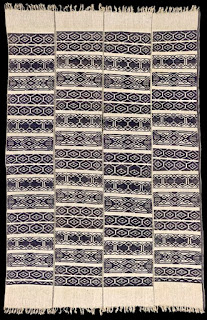Cloth and The Masquerade in Southern Nigeria
Unlike many other artforms, textiles have the ability to operate in thee dimensions. When wrapped around the body they become three-dimensional taking the form of their wearer's body, or draping from it. In the form of tapestries, they can function like paintings or decorate backdrops. Across the African Continent, they can also enter the fourth dimension as part of the energetic moving spectacle of the masquerade. Both imported and locally made textiles play significant roles in the masquerade traditions of Africa. Locally made cloth is often integral to the construction of these costumes. These textile pieces often take on new ritual significance as they are imbued with medicinal and spiritually potent substances. In southern Nigeria, particularly in places where upright loom weaving is prominent, ritual textiles made in this way are often repurposed in masquerade celebrations. The ritual textiles made by the Ijebu weavers for the Ogboni society often become repurposed as part of the Egungun masquerades in the area and beyond. The textiles of In some instances, these textiles may have been created some distance from where they were created. A prime example is the Aso Ipo textiles made by the Abunu Yoruba people living in Kogi state Nigeria. These textiles are originally used as part of funeral rituals but are used as part of masquerade costumes across the region. Similarly textiles woven by the igbo people in Nothern and central igboland, and their Igala neigbors often become essential parts fo masquerades all over igboland.
An image of the Oji Onu mask in igboland wearing a costume made of cotton woven on an upright loom dyed with stitch resist patterns







Comments
Post a Comment